B
|
|
| Badhamia foliicola (an unusual slime mould with no English name) |
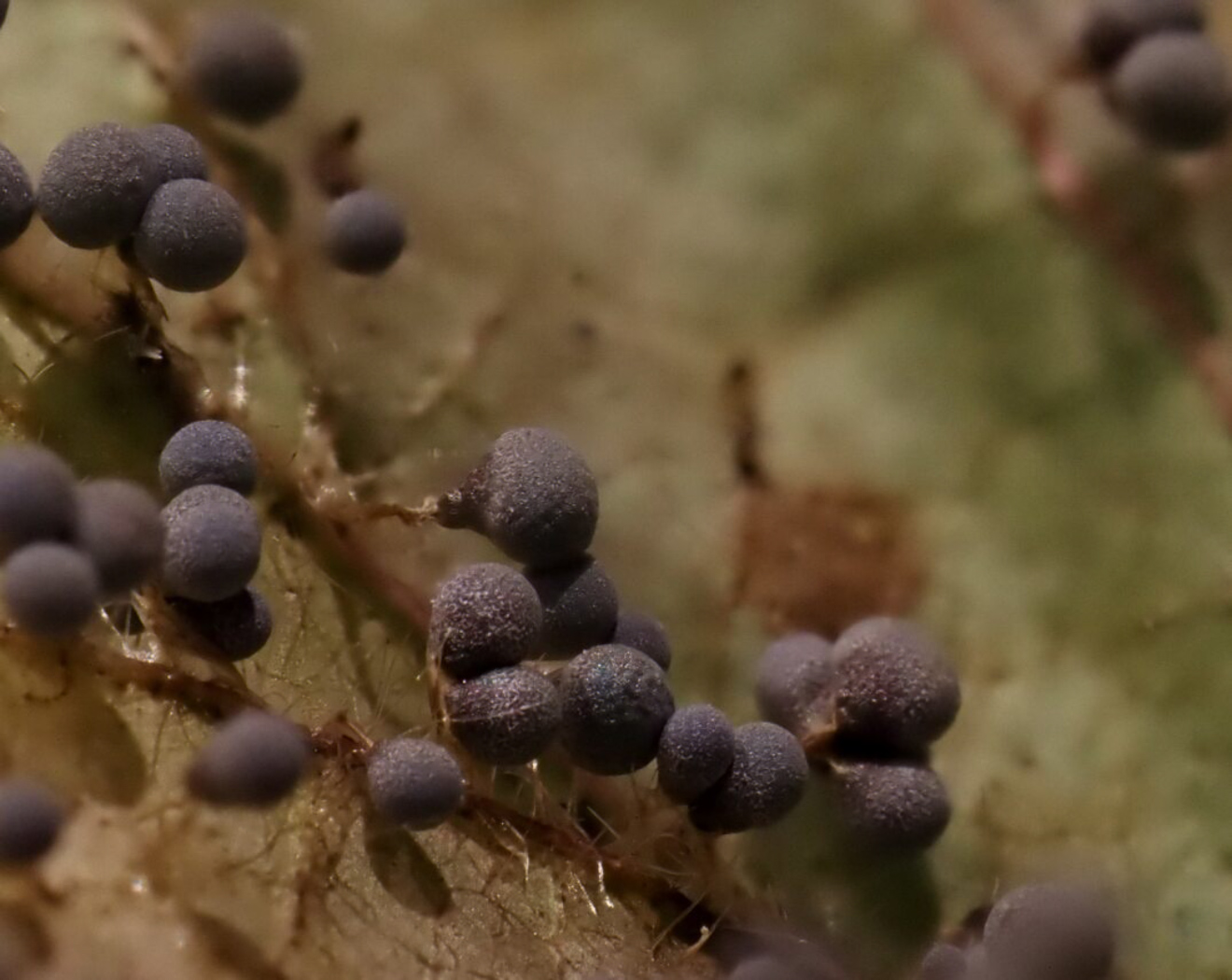
|
Nov 12, 2025.  At Stoke Common on our BFG Walk Barry Webb found this tiny species, new to the county, on a living Bramble leaf and spreading onto adjacent vegetation. His immature sample was then retained by Jackie Mackenzie-Dodds until maturity had been reached, at which stage identification could be attempted. The thin weak short stem is a notable feature and this together with other microscopic characters and its preference for growing on vegetation then clinched her identification. The photo is Justin Warhurst's. At Stoke Common on our BFG Walk Barry Webb found this tiny species, new to the county, on a living Bramble leaf and spreading onto adjacent vegetation. His immature sample was then retained by Jackie Mackenzie-Dodds until maturity had been reached, at which stage identification could be attempted. The thin weak short stem is a notable feature and this together with other microscopic characters and its preference for growing on vegetation then clinched her identification. The photo is Justin Warhurst's.
|
| Baeospora myosura (Conifercone Cap) |
 |
Sep 20, 2024. In Rushmere Estate Stephen Plummer noticed this Pine cone nicely adorned with this little 'mycenoid' species. Apart from always growing on cones, its main distinguishing feature is the extremely crowded and rather shallow gills, and it typically has rather a strigose stem base - very pronounced in this example. It is quite common wherever Pines occur. |
 |
Nov 8, 2023. In Bernwood Forest Chris Grimbly found this Spruce cone liberally covered in little mushrooms and sent the photo to Penny for confirmation. Though the crowded gills associated with this species are not visible here, there can surely be little doubt over its identity, also we found and identified it at Stoke Common a few days earlier and it is not at all rare. |


 |
Nov 29, 2022. Under the many Pines at Stoke Common this LBJ species was really common despite the very flooded conditions - it was on the cones in large numbers. The only other genus with which it might be confused if given this substrate is Strobilurus, and the features to look for to separate the two are the very crowded buff gills of the Baeospora, seen here in photo 3, also the evenly buff stem - in Strobilurus the stem is white above then yellowish ochre below. (There are very distinct microscopic differences also.) |

 |
Oct 5, 2020. Not far from the Mycena sanguinolenta also under the Douglas Fir today, Penny Cullington found this species in Common Wood. It grows on fallen rotting cones of various conifers, as do several other similar species, but this one can usually be recognised by its very crowded gills (see photo 2). The caps today were small, less than 1 cm across, but can be found twice this size. |
Balsamia platyspora (Broadspored Truffle)  |

 |
Apr 22, 2024. This species, in Jesper Launder's garden, was his fourth species of Truffle to be found under his Lime tree in the space of two days! Amazing! This is the third year running that he's found it here though this is by far the earliest date as can be seen from our previous entries. See the notes with those records for more. Photo 2 is of a further find he made on June 3rd under Hornbeam in Gerrards Cross. |
 |
Jun 29, 2022. In his Jordans garden Jesper Launder found this small and distinctive truffle under the same Lime tree where he found it last July. His find last year was only the second county record for the species though it's probably not that rare but most mycologists (Penny included) don't think to look for truffle species nor are very sure how to go about doing so. Balsamia is one of the Ascomycete truffle genera though others belong with the Basidiomycetes. |

 |
Jul 9, 2021. Whilst isolating in his Jordan garden Jesper Launder found this rarely recorded truffle in grassy soil under Beech and Lime. This is apparently a small brown warty truffle (seen here sitting on a Lime leaf for perspective) with a pale veined interior and - being a member of the Ascomycetes - it has unusual asci which are balloon-shaped with clusters of ellipsoid spores. We have just one previous county record, from Derek's Whitchurch garden 10 years ago found by truffle expert Carol Hobart who was dogsitting whilst they were on holiday! |
Balsamia vulgaris (Common Truffle)  |
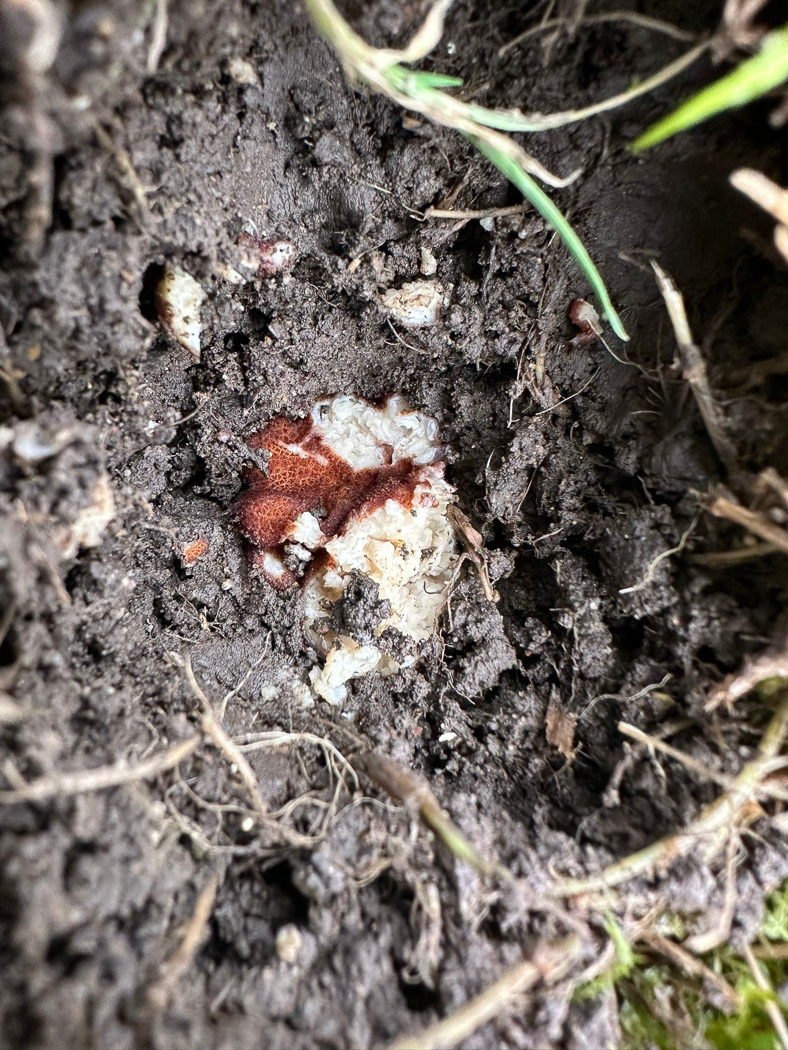
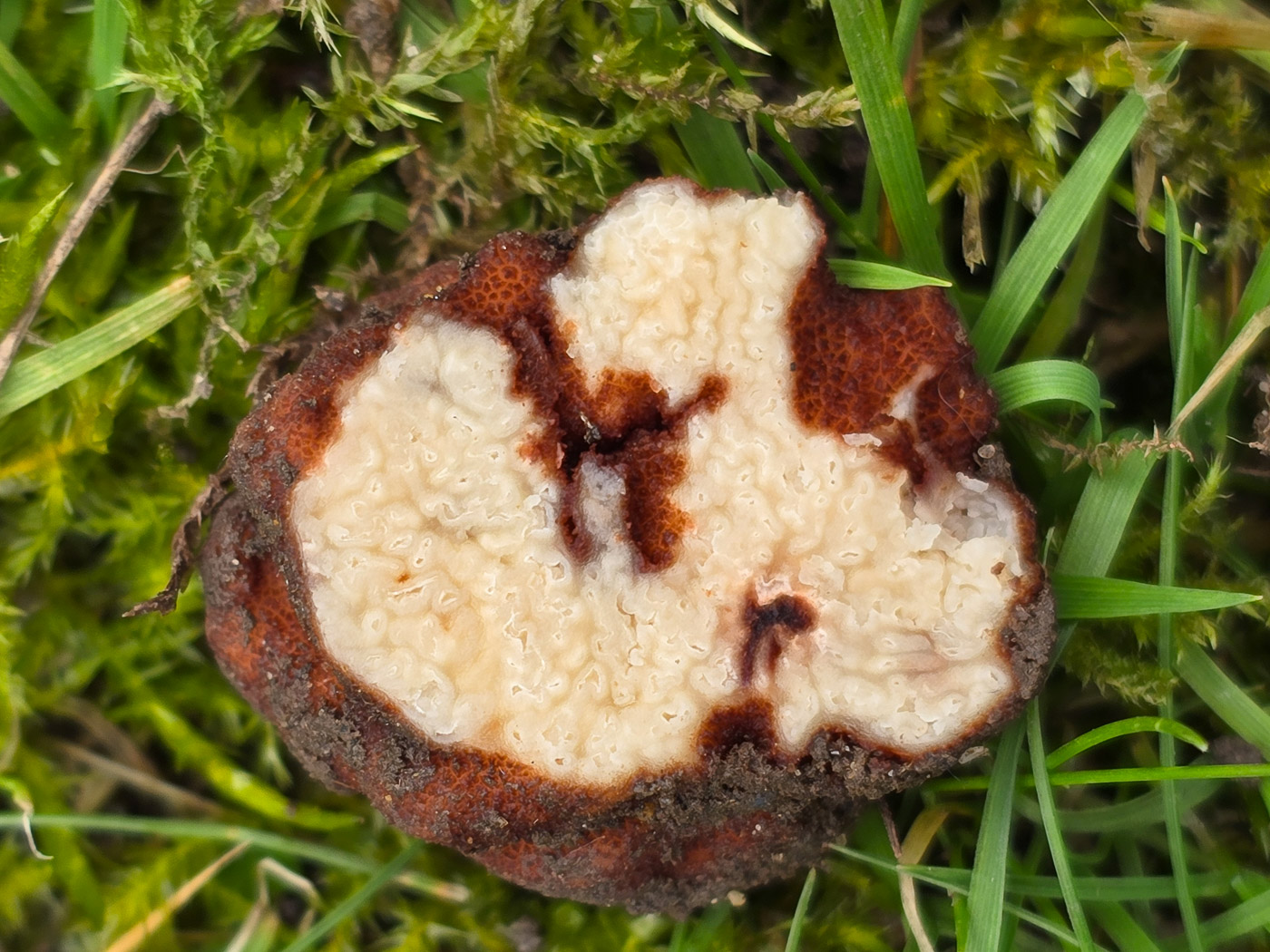 |
Jan 17th, 2025. In Gerrards Cross Jesper Launder found this knobbly whopper (his description!) partially showing through the soil surface under a deciduous tree, also partially eaten by a squirrel (detected from its toothmarks!). He was surprised by its size (more than 3 cm across) which was not fully revealed until excavated, and was the largest and also the smelliest he'd encountered (described by him as 'truffly and pleasant'). This is his second find of this species from Gerrards Cross where the number of truffle records - entirely down to him - is growing rapidly, and is the second county record. |
 |
May 31st, 2024. Whilst searching for little animals' 'dig holes' under an Oak in Gerrards Cross known to Jesper Launder for truffles in previous years, he struck lucky with this one, a species new to him and with only 8 records in FRDBI - none since 2010. Recognising the genus (he's an experienced truffle hunter) he worked carefully on it at home, comparing the micro-details with those of the much more common and very similar B. platyspora, before making his ID. As this is new to the county a sample will be sequenced to confirm further. |
| Bartheletia paradoxa (a rare Ascomycete with no English name) |

 |
Oct 27, 2022.  At Stoke Poges Memorial Gardens, when Stephen Plummer learnt that there was a Ginkgo biloba tree here, he recalled reading about a rare Asco which only occurs on the leaves of this particular tree, so went searching for the tree and found the fungus! Not surprisingly there are only a very few British records of this species which is new to the county, so all credit to Stephen for knowing about it. At Stoke Poges Memorial Gardens, when Stephen Plummer learnt that there was a Ginkgo biloba tree here, he recalled reading about a rare Asco which only occurs on the leaves of this particular tree, so went searching for the tree and found the fungus! Not surprisingly there are only a very few British records of this species which is new to the county, so all credit to Stephen for knowing about it.
|
Basidioradulum radula (Toothed Crust)  |
 |
Feb 21, 2025. On a fallen Prunus branch at Stampwell Farm Jackie Ewan found this toothed resupinate corticioid which however is very similar to Radulomyces molaris (Oak Toothed Crust) and from Jackie's photo Penny was not confident to confirm which of the two species we have here. The latter tends to occur high up on attached deciduous branches - not necessarily Oak despite the name - but after strong winds it can often be found on the ground. However, when Jackie learnt of Penny's doubts she then checked the spores which luckily differ in shape between these two similar species and was able to confirm her initial ID! |

 |
Mar 7, 2023. On a twig, possibly Cherry, on Austenwood Common (Gerrards Cross) Jim Wills noticed this species - a nice example of a common corticioid. It starts out as small roundish patches with a white rim and a cream 'toothed' centre, the patches gradually coalescing into larger longer patches as can be seen in both photos here. |
 |
Jan 31, 2022. In woodland near Jordans Village Jesper Launder noticed this resupinate on fallen Cherry. This is one of our commonest corticioids, growing on the bark of many different deciduous fallen woods. It starts out forming small roundish patches, white and smooth at the edge but cream and almost toothed in the centre. Gradually the patches coalesce to form larger areas as here. |
 |
Feb 13, 2021. Jesper Launder braved the elements to find this common 'corticioid' fungus fruiting on fallen Prunus in Crutches Wood near Jordans. We have a previous immature example (dated Jan 28th) but today's photo shows the species in its typical dry and crusty state (having survived both snow and frost) but still showing its tendency to form roundish patches with a white rim but a darker cream and roughened almost 'toothed' centre. |
 |
Jan 28, 2021. Claire Williams spotted this example of young material of a common resupinate corticioid species in Downley Common fruiting on fallen deciduous wood. At this stage of development it is pretty well all whitish but clearly with a 'toothed' appearance, but when mature it tends to develop rounded patches with creamy centres. |

 |
Dec 7, 2020. On various sticks in Penn Wood Penny C. found examples of another very common resupinate fungus. The surface is not dissimilar to that of the Schizopora described above, i.e. roughened and almost toothlike especially in the centre, however unlike that species it does not form a large even covering over the wood but is recognised by its round individual creamy patches which start out about 1 cm across, each individual patch white and frilly at the edge and raised, darker and almost furry in the centre. It is common on deciduous wood but less usual to find on conifer - here it was on Larch. |
| Battarrea phalloides (Sandy Stiltball) |
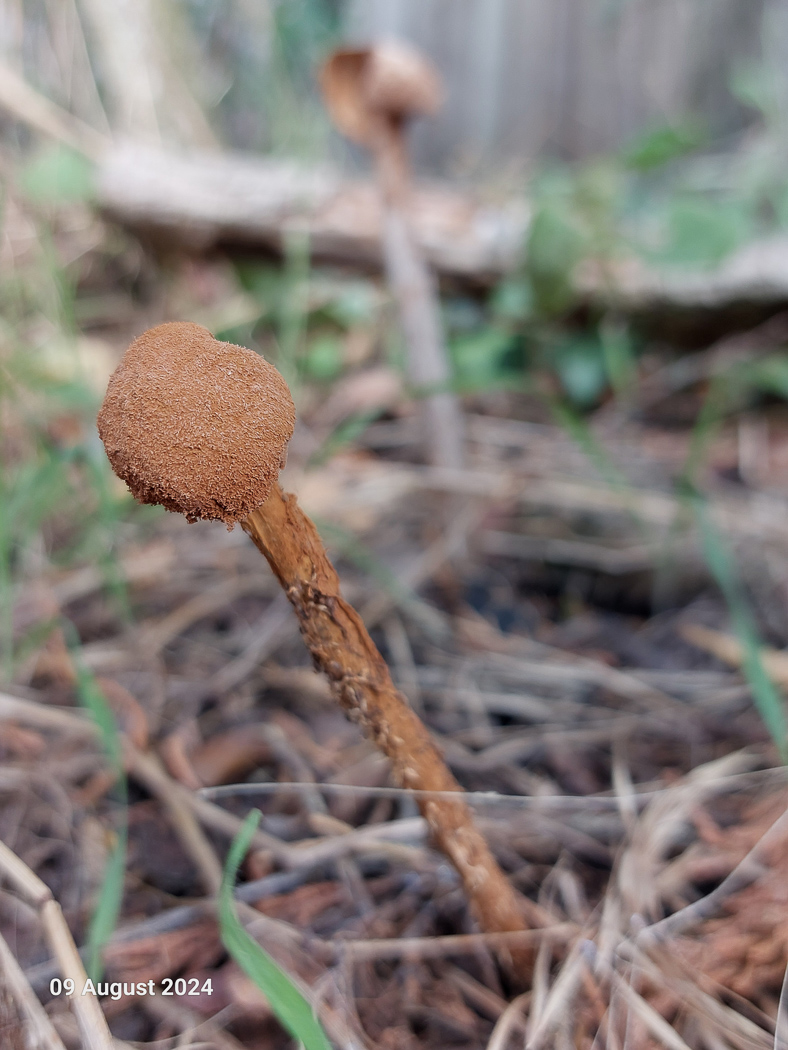
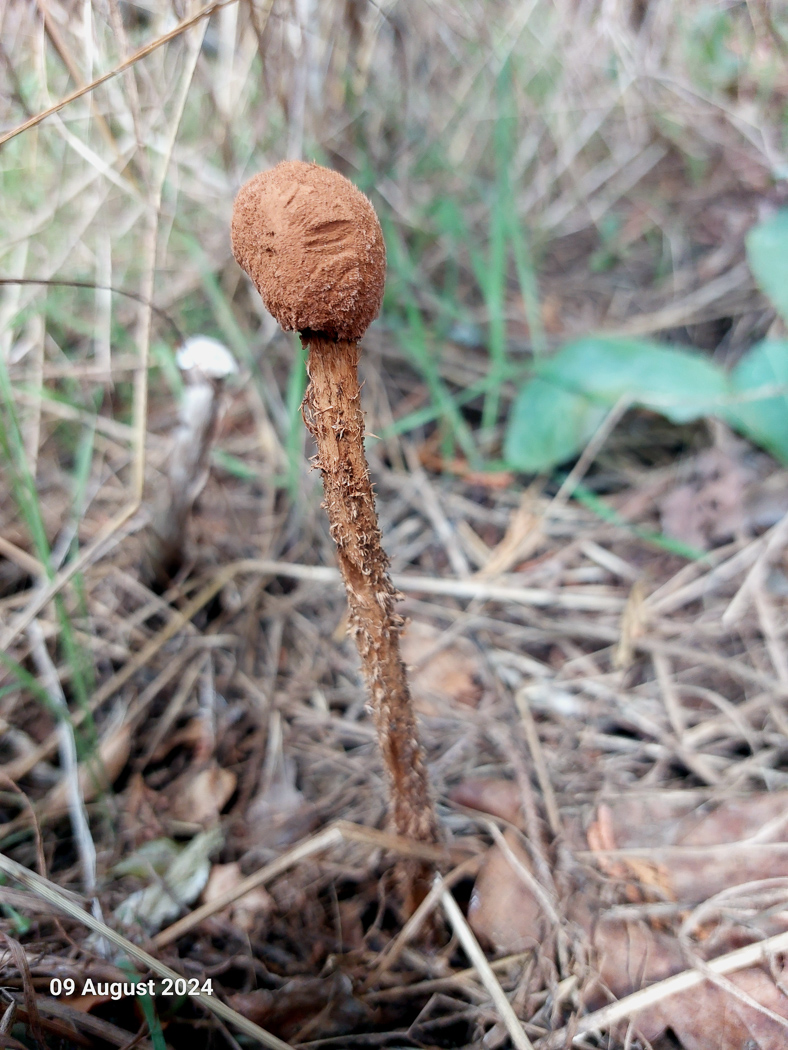
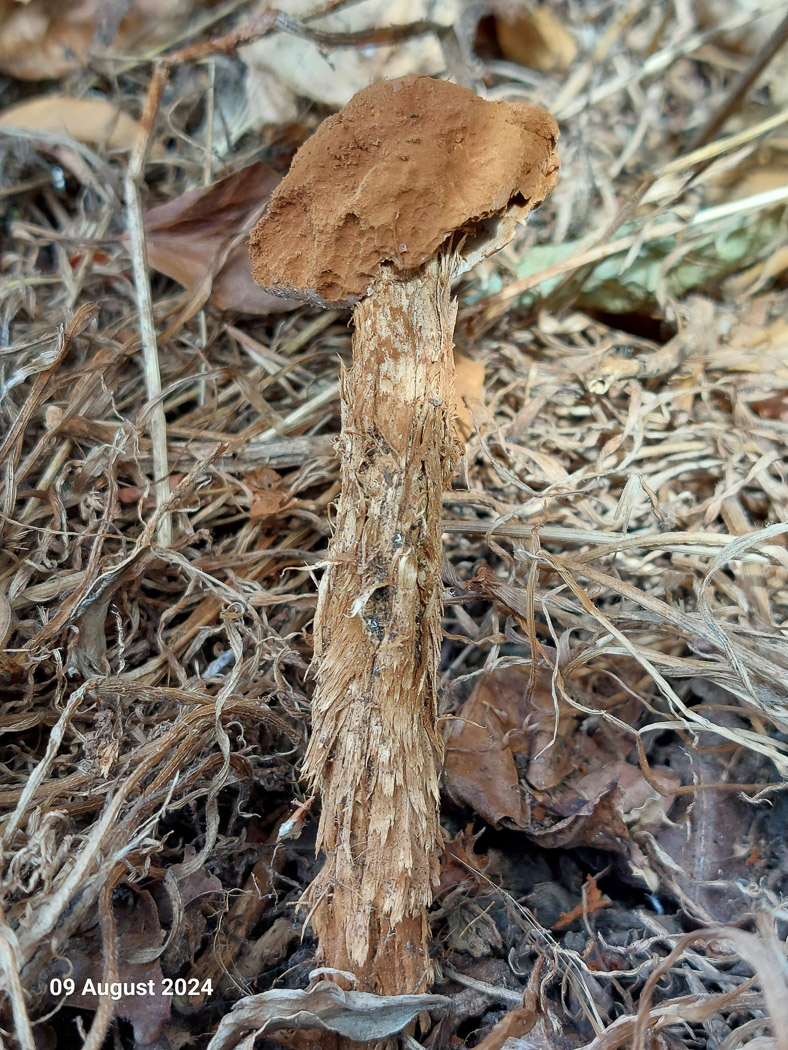
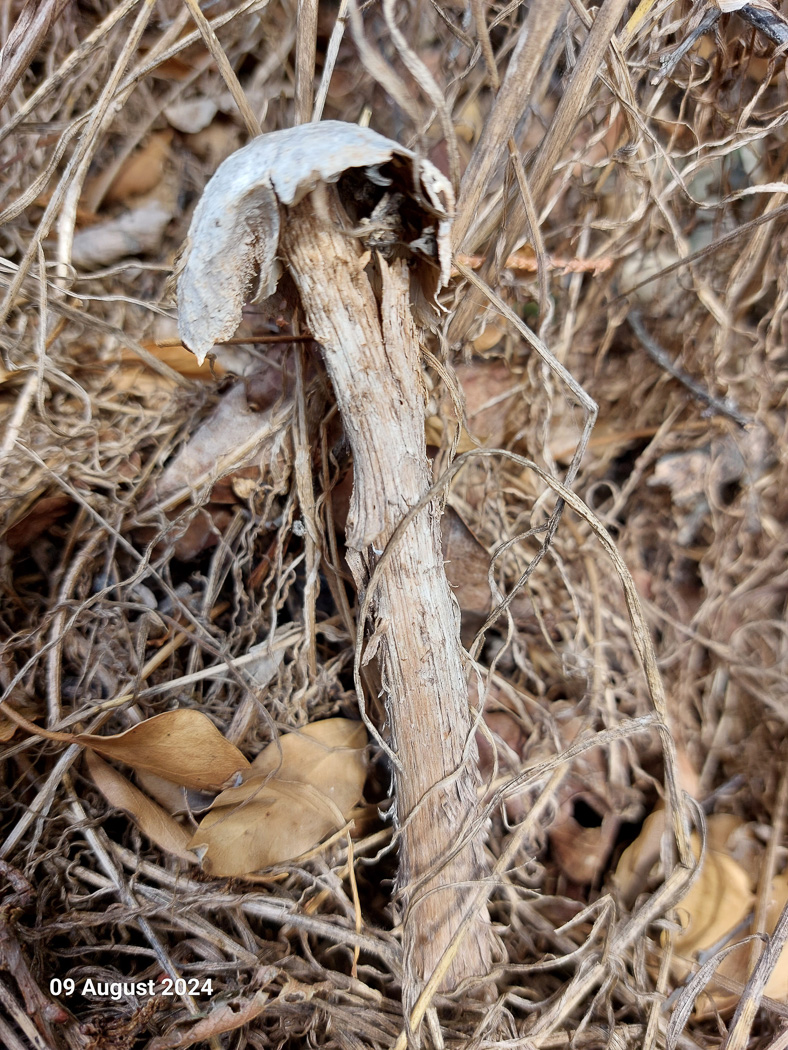 |
Aug 9, 2024.In Fulmer Jesper Launder was both astonished and delighted to spot a group of these rare and strange looking fungi in a dry grassy roadside bank near some Leylandii. Related to the gasteroid (stomach) fungi, the species is on the Red Data List and as such protected by law (thus should not be picked). Jesper reports that there were three fresh stalks about 10 cm tall amongst some 6 or 7 much older dilapidated specimens - probably left from last year. The species is woody and tough, also somewhat unpredictable where it fruits, but does seem to like banks with sandy soil near conifer and has now been found several times in the county, always in urban areas. This is the second find of the year and we now have four similar sites for it in Bucks, so rather like the equally strange and also gasteroid species Clathrus ruber it does seem to be on the increase. Climate change? |

.jpg) |
Mar 10, 2024. In an urban lane near Burnham Russell Ness happened upon a rare species he'd long been hoping to see one day. This strange fungus, related to Puffballs and the like, was growing in the litter under some Cypress trees - about 11 stems were present, mostly missing their puffball tops but two were complete enough for him to photo and collect some remains which still retained some spores which he was able to examine. No doubt this collection fruited here back in the autumn and their remarkable tall woody fibrous stems enable them to survive for months afterwards. We have just two other known sites for this rare and often elusive and unpredictable species, so this was a notable find. |
 |
Sep 18, 2022. On the offchance of finding this strange and rare species, Richard Fortey and Linda Seward called in at the (unrevealed) spot where it has now been fruiting for the last few years, first discovered here by Richard. Not only was last year's specimen still there but Linda's photo shows this year's specimen nearby. The species is related to puffballs, earthballs and the like but is unique in having this tall almost woody stem - anything up to 25 cm high. See also in Finds 2020 October 5th and 2021 Sept 14th. If you find this species anywhere please report it to Penny. |


 |
Sep 14, 2021. Penny was delighted to hear from Richard Fortey that this rare species (on the Red Data List and new to the county last year) was fruiting again in the same location in the south of the county - not revealed here for obvious reasons. She went in search and found the two specimens standing about 20 cms tall with heads 4-5 cms across, the shaggy stems being remarkably solid and sturdy (almost woodlike) and the heads powdery. The species is related to the Stinkhorns, arising from a gelatinous egg which has a solid outer coating and lacking the Stinkhorn smell; it appears to have a preference for sandy soil, occurring unpredictably in hedgerows, at roadsides mainly in the south. Last year it also turned up in Chesham, and when Jackie McKenzie-Dodds and Justin Warhurst went to check for it at this spot on Sept 26th there it was again! Photos 1 and 2 are Penny's on Sept 14th, photo is Justin's on Sept 26th. |


 |
Oct 5, 2020. Richard Fortey was extremely excited to come across this very rare and unique species at a location in the south of the county. With very few known sites - all in southern or eastern England - it is new to Bucks. The species is loosely related to puffballs and stinkhorns, arising from a volva-like sac with a shaggy hollow stem up to 20 cms tall and topped with a cinnamon brown puffball-like head which contains the spores. It occurs all over the world in dry sandy places / deserts and appears to be moving north possibly as a result of global warming? |
| Beauveria bassiana (an asco with no English name) |
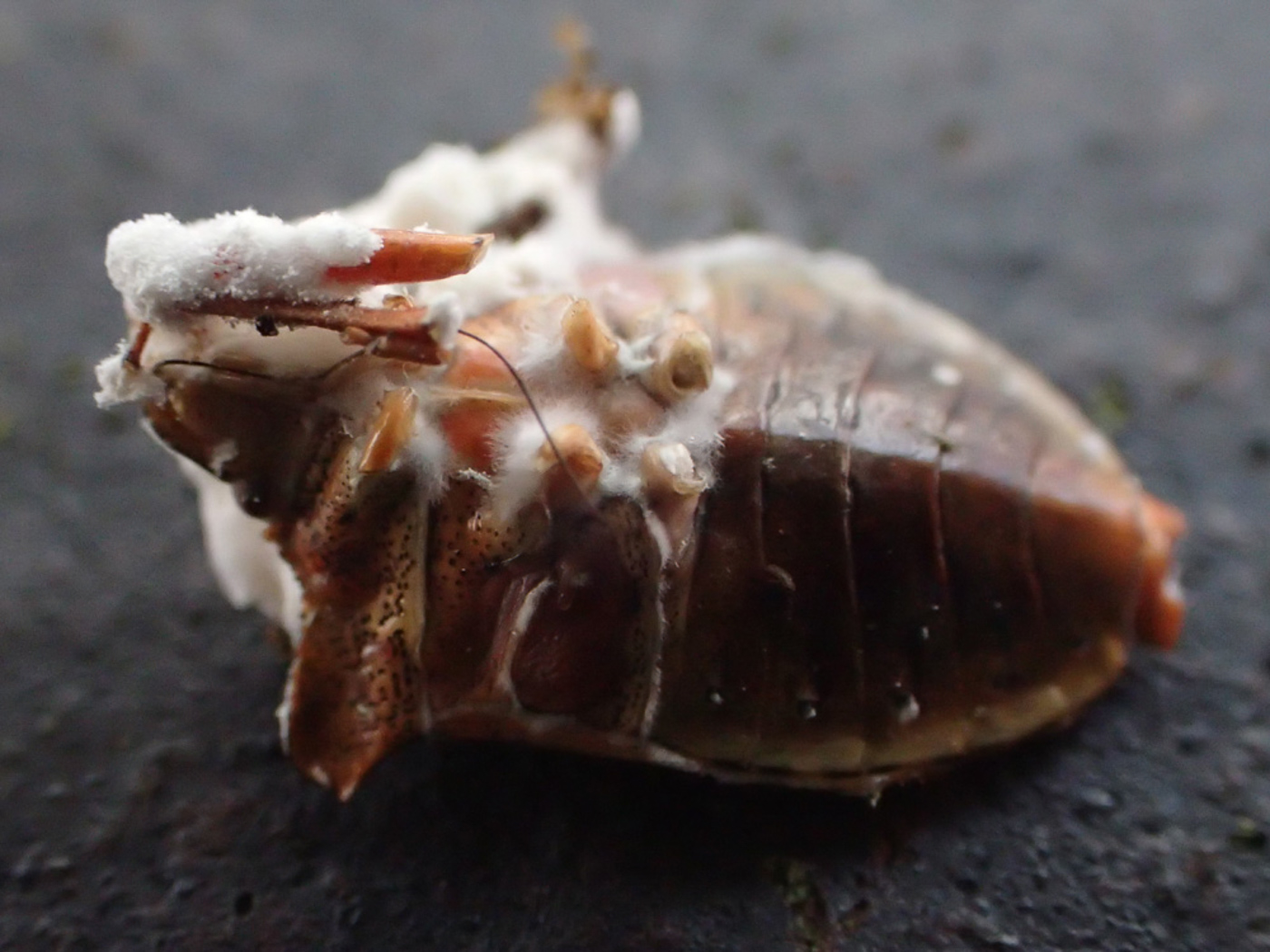
.jpg)
.jpg)
|
Oct 25, 2025.  In Gt Bois Wood Arboretum near Chesham Sarah Ebdon spotted this small shield bug rather brutally infected with a fungus which she recognised, having found it several times before though we appear to have no entries in the BFG database. There are around 60 entries in FRDBI so it is not that often found though for obvious reasons could obviously go unspotted. In Gt Bois Wood Arboretum near Chesham Sarah Ebdon spotted this small shield bug rather brutally infected with a fungus which she recognised, having found it several times before though we appear to have no entries in the BFG database. There are around 60 entries in FRDBI so it is not that often found though for obvious reasons could obviously go unspotted. |
| Biscogniauxia nummularia (Beech Tarcrust) |
 Stoke Common 26.01.24 JW1.jpg)
 |
Jan 26, 2024. On fallen Beech at Stoke Common Jim Wills noticed these black lozenge-shaped patches which were easily recognisable as this species - given the correct host wood. Compare his photos with those of Diatrype stigma (Common Tarcrust) - very similar and also found on fallen Beech but forming much larger patches and not lozenge-shaped as here. Both species, however, are equally common despite their common names. (Incidentally the black blobs beneath were thought to be Hypoxylon fragiforme though this determination was questioned by Penny therefore not included as a separate entry in Finds for that reason.) |


 |
Aug 27, 2023. In Park Wood Ibstone Penny thought she'd add an example of this very common species to our Finds collection of images. The species - a Pyrenomycete Ascomycete - is often present on fallen Beech bark though not always recognised. Its black irregularly lozenge-shaped flat blotches are distinctive, however, and can occasionally join up to form bigger patches. See also in Finds 2020 December 7th. |


 |
Dec 7, 2020. On the same wood pile in Penn Wood as the Schizopora Penny C. found these black almost smooth lozenge-shaped patches dotted about on a Beech branch. This is one of quite a few common crusty black Ascomycetes which favour smooth barked deciduous wood and is nameable in the field if one notices its typical rather irregularly roundish flat patches which are about 1-2 cms across. Close up the tiny 'ostioles' (bumpy openings through which the spores are expelled) can be seen covering the surface. |
| Bisporella pallescens (no English name) |

 |
Oct 28, 2022. On a hardwood log in Austenwood Common, Chalfont St. Peter, Jim Wills found two species of Bisporella growing together - photo 1 (see also the entry immediately above). The white discs were clearly not B. sulfurina and at home he discovered it must be the much less common B. pallescens, one which also grows on old black Pyrenomycetes. Unfortunately spores could not be found so the ID has to remain unconfirmed, but many images of this species online show both the white and sulphur yellow species adjacent as here. The species appears to be new to the county.
|
| Bisporella subpallida (an Asco related to Lemon Disco with no English name) |

 |
Jan 29, 2022. Over the last couple of weeks Jim Wills has been keeping an eye on this colony of tiny cups he found on a sawn end of a deciduous trunk in Chalfont St. Peter, suspecting it might be maybe frosted material of something like Bisporella citrina (Lemon Disco). However, it appeared to be thriving, clearly palish ochre and not yellow, also consistently a bit frilly round the edges, so he sent the photos to Penny for confirmation. Without checking the spores one cannot be entirely sure, but this does appear to be very convincing material of a species for which we have only a few records. (The somewhat similar B. pallescens is also a possibility here but is paler still and grows on the black silky surface of an early stage of Bispora antennata, not seen here.)
|
| Bjerkandera adusta (Smoky Bracket) |


|
Dec 3, 2025. At Burnham Beeches Penny found this row of small brackets on fallen Birch and was unsure what it was until she was able to turn the branch over. The grey almost smooth undersurface having a clear white margin gave the game away though this white rim is often much wider and more obvious than here. |
 |
Dec 12, 2024. At Burnham Beeches Penny noticed this common species fruiting in rows all along a fallen Beech trunk. Looking quite similar, as it does, to the even more common Trametes versicolor (Turkeytail) it's always worth checking a piece by turning it over to see the smooth smoky grey underside but with a white exterior rim - distinctly different from the all white pored underside of Turkeytail. |

 |
Sep 13, 2022. In Burnham Beeches Penny found good examples of some smallish soft fleshed brackets on fallen Beech, all common but different species which tend to get confused. Hence this attempt to show the obvious differences. Smokey Bracket is so-named because of its smooth smokey grey undersurface which separates it from the even more common Trametes versicolor (Turkeytail) which is obviously pored and entirely creamy white underneath. Note also its white rim and dark staining where rubbed - visible on the right in photo 2. We have probably better images elsewhere on Finds (apologies for Penny's here which are somewhat blurred). |


 |
Nov 9, 2021. On a Beech stump in Burnham Beeches Penny found this species and promptly picked one to turn over and check that it wasn't the often very similar Trametes versicolor (Turkeytail), one of our commonest brackets. Both have a zoned upper surface though 'Bee Jay' - as it's sometimes referred to - is usually (but not always) a darker brown. The obvious difference is the undersurface - creamy white and clearly with pores in the Trametes but smoky grey, almost smooth with a white rim in BJ, the grey part bruising black when handled (see photo 3). |

 |
Nov 30, 2020. On a Birch stump in the Mire at Burnham Beeches Penny C. found this attractive example of a common bracket though one which tends to be overlooked, being mistaken for the even more common Trametes versicolor. The zoning on the top is indeed quite similar to that species, but turn one over and the difference is very clear: greyish black and smooth with a white rim in 'BJ' as opposed to creamy white with distinct pores in Turkeytail. See also our earlier photo dated Oct 03. |

 |
Oct 3, 2020. Sarah Ebdon found this cluster of brackets on fallen Beech in Naphill Common. Another common species of fallen deciduous wood and often appearing superficially very similar to Turkeytail (see photo dated Sept 26) the distinctive feature lies underneath (as with so many species of fungi!). The very fine pores are smokey grey but with a distinct white rim around the edge in contrast to the pores of Turkeytail which are entirely creamy white and also larger - more obvious to the naked eye. |
| Bolbitius reticulatus (Netted Fieldcap) |

 |
Oct 10, 2020.  When Penny Cullington saw this small mushroom on a rotting Beech pile in Gussetts Wood she thought it was a species of Pluteus (Shield). The gills were free (unattached to the top of the stem) as they should be for this genus but seemed to be too rusty brown rather than pink. At home the spores were entirely the wrong colour and shape for Pluteus, so it was back to the drawing board with a lengthy key to genera to wade through. The sticky cap was a useful clue and eventually all features, including microscopic, fitted into place. Not really rare but with few county records, this was a new species to Penny. When Penny Cullington saw this small mushroom on a rotting Beech pile in Gussetts Wood she thought it was a species of Pluteus (Shield). The gills were free (unattached to the top of the stem) as they should be for this genus but seemed to be too rusty brown rather than pink. At home the spores were entirely the wrong colour and shape for Pluteus, so it was back to the drawing board with a lengthy key to genera to wade through. The sticky cap was a useful clue and eventually all features, including microscopic, fitted into place. Not really rare but with few county records, this was a new species to Penny.
|
| Bolbitius titubans (Yellow Fieldcap) |
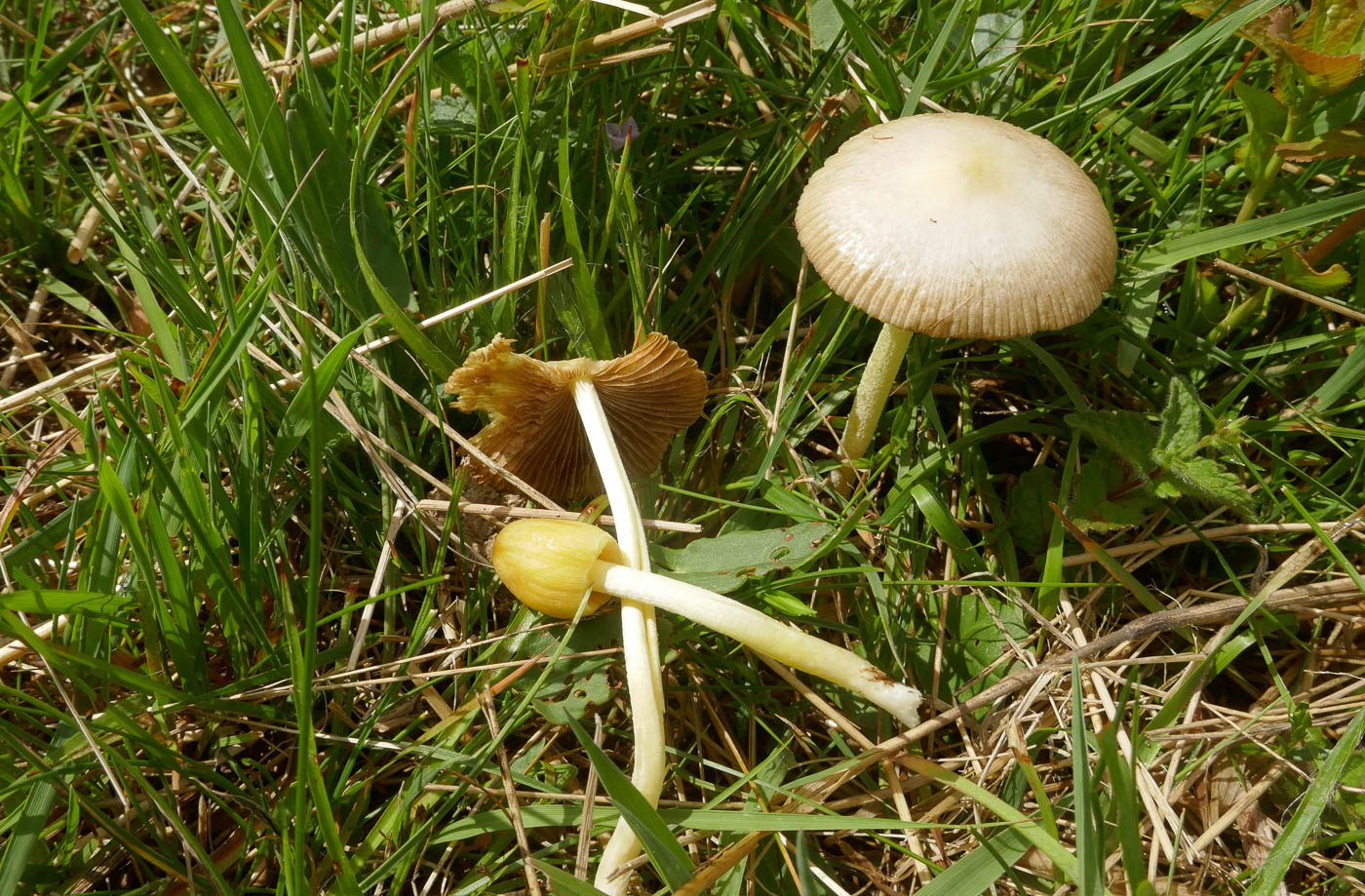
|
May 29, 2025. At Stampwell Farm Jackie Ewan was not surprised to find this grassland species appreciating the recent rains. See previous finds for further info on the species.
|
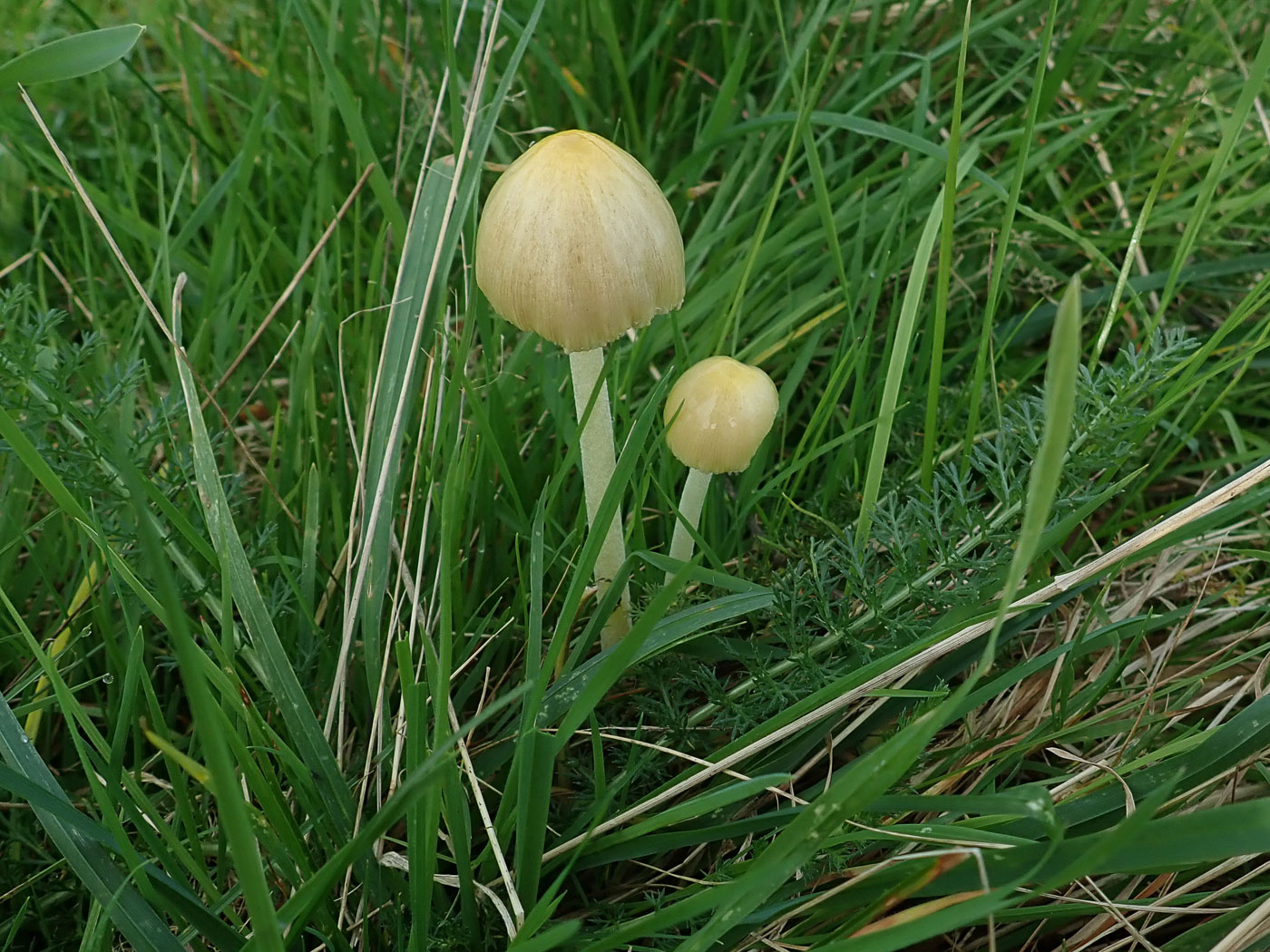
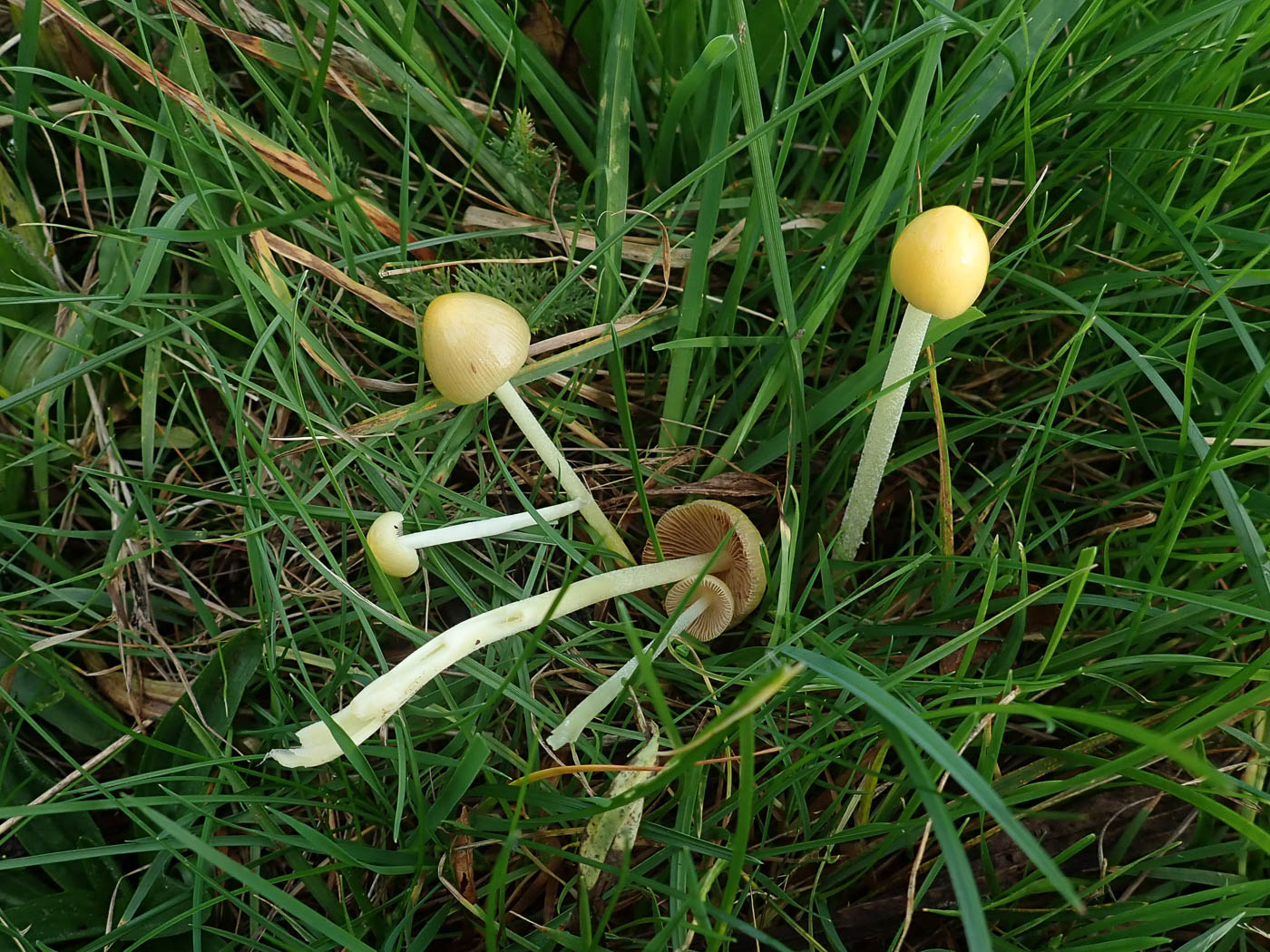 |
Nov 4, 2024. At Burnham Beeches Penny found this normally common grassland species fruiting nicely, but it caught her attention because she's hardly seen it at all so far this season and has been notably conspicuous by its absence. |

 |
Sep 27, 2022. In longish grass at Turville Heath Penny found this nice pair glistening in the light rain and couldn't resist the photo. When mature as here only the centre of the cap remains egg yolk yellow, when its thin flesh and well spaced gills help to confirm its identity. |

 |
Sep 12, 2022. In Bradenham Woods Claire Williams noticed these small bright yellow caps emerging though a pile of deciduous woodchips. More often recorded from soil in grassy path edges, this common species seems just as happy in this medium. |
 |
Jun 20, 2022. Though we have several images of the species, this one received by Penny today from Bob Simpson is worth including. Found on a woodchip pile in Salden Wood (and identified as B. titubans by Bob though with some doubts) it is not only surprisingly substantial but also has rather a 'woolly' stem - both characters not often seen in the species. Both Penny and Derek are happy that it is correct, however, noting that its size tends to depend upon substrate and conditions. Derek's comment: 'This species always amazes when conditions are right, producing larger than usual fruitbodies with more pruinose/floccose stipes.' |

 |
Jun 13, 2022. In a grassy path edge at Turville Heath Penny found this mature singleton with enough of its yolk yellow cap still just showing at the centre. The thin flesh and gills similar to a Parasola Inkcap, also its sticky stem and cap helped to confirm its identity.The species made an even earlier appearance on May 16th, with other images available in earlier years of Finds. |
 |
May 16, 2022. This was one of only two agarics found by our small group at Dancersend - a common species though more often found from summer onwards in grassy paths rather than on a woodchip pile as here. Its previous name was B. vitellinus and the photo is Neil Fletcher's. |
 |
Jul 15, 2021. At Cadmore End Penny found a collection of this common grassland species in roughly mown grass. It has a sticky cap which one can tell from the bits of dead grass adhering to the tall specimen here, and the bright egg yellow cap colour when young gradually fades as it matures. Possibly confusable with one of the yellow Waxcaps when young, a sporeprint will soon eliminate that genus: white in Waxcaps but distinctly brown in Bolbitius. |
 |
Nov 1, 2020. We do have previous photos of this delicate grassland species (dated Sept 29) but when Penny C. saw these in Winchmore Hill Common she couldn't resist including them again. Only a couple of cms high, they were at the perfect rounded conical stage when caps are yolk yellow and gills are still white, with one older specimen conveniently nearby to show how the gills darken as the spores mature. |


 |
Sep 29, 2020. Penny Cullington found this small grassland species (previously B. vitellinus) in a meadow at Rushbeds Wood. It is common in grass, also sometimes in woodchips, though is a delicate species and rather shortlived. Very thin fleshed and not unlike one of the Parasola group of Inkcaps in form, when young the cap is entirely yolk yellow then as it expands develops the typical grooves seen here on this singleton, retaining the yellow only at the centre. As luck would have it, Penny found young specimens the following day at Turville Heath growing on woodchip, which demonstrate just how strikingly yellow the species starts out. |
| Boletus aereus (Bronze Bolete) |
 |
Jul 16, 2023. In Bernwood Forest Jesper Launder chanced upon some Ukranian ladies collecting mushrooms for the pot and in their basket were these two beauties (which he then borrowed for the photo!). This is a rare Bolete closely related to B. edulis, occurring in S. England under Beech and Oak but not one Penny has ever seen. It has a more intensely dark reddish brown cap and a pale brown clavate stem having a darker brown network. this was new to the county and also to Finds.
|
| Boletus edulis (Penny Bun / Cep / Porcini) |

 |
Jul 19, 2023. Little and Large: In Kings Wood, Tylers Green, this small button was one of the few fungi Penny was able to find, though hopefully it was a promising sign of things to come! A few days later in Bernwood Forest she came across this whopper (photo 2) all of 15 cm across! |
 |
Sep 23, 2022. At Stampwell Farm under Oak Jackie Ewan found this Bolete - one of very few still remaining in the genus Boletus! - fruiting despite the continuing dry conditions. Boletes generally seem to be the only group of mycorrhizal mushrooms doing OK at the moment, particularly those which thrive in grassy rather than purely woodland habitats - this reflected on Members Finds in the remarkable number of species found by Jesper Launder around Jordans village in recent weeks. |

 |
Sep 11, 2020. Two separate collections of a species which seems to be fruiting well at the moment: the singleton is from Bradenham Woods and the doubleton from nearby Naphill Common a week earlier by Sarah Ebdon. One of very few boletes which still retain the genus name Boletus, it has pores which don't stain blue when pressed and that often become yellow as it matures. |
| Boletus reticulatus (Summer Bolete) |
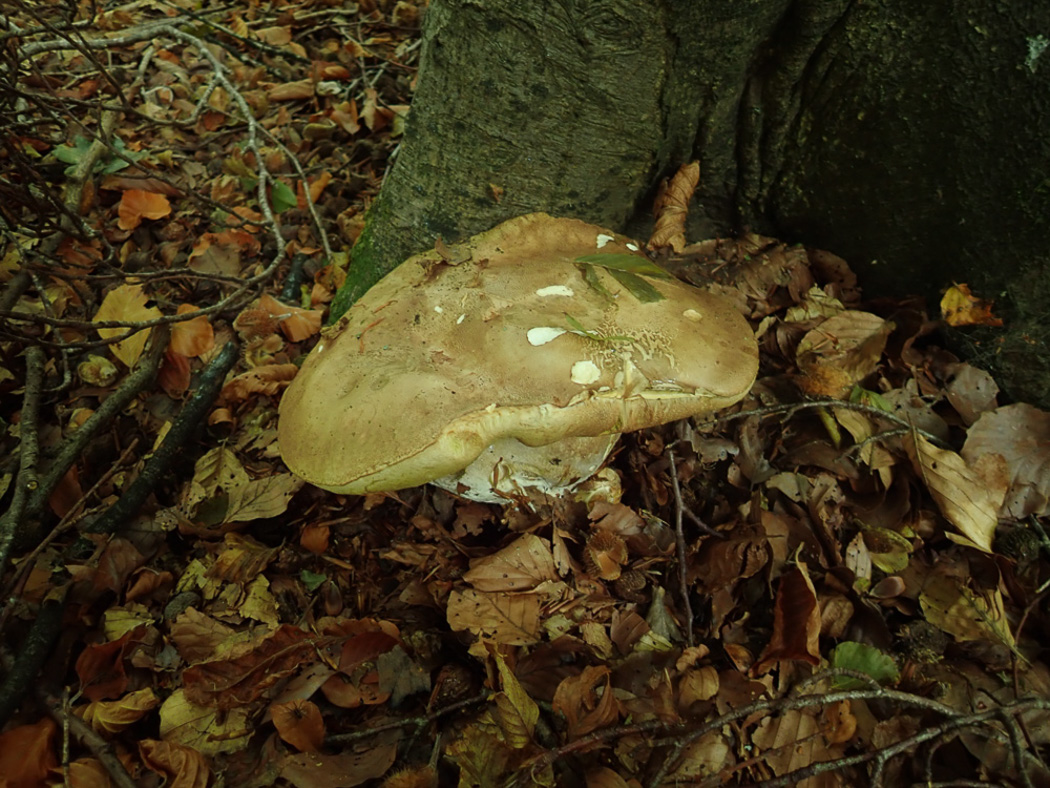
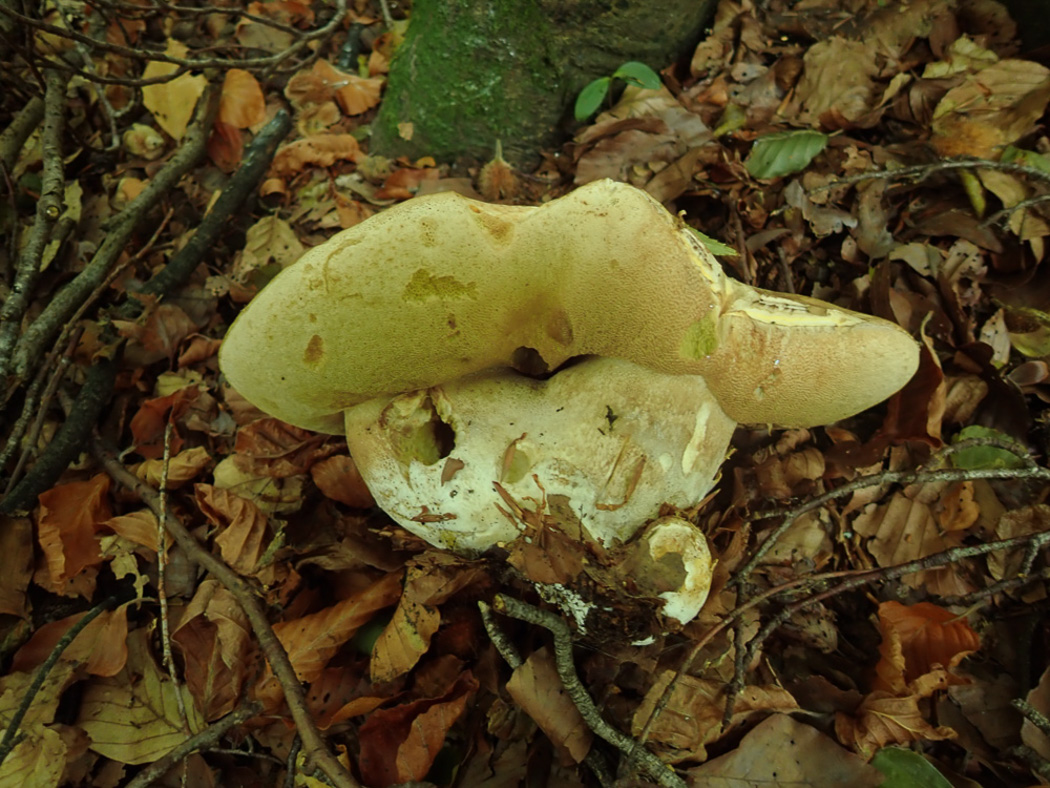
|
Oct 7, 2025. At the base of a Beech trunk in Gussetts Wood Penny could hardly miss this huge mushroom which must have been not far off a foot across! Turning it over revealed that two fruitbodies appeared to have merged together (or one had split apart) to form this monster, clearly one of the edible boletes. Geoffrey Kibby the next day named it B. reticulatus rather than B. edulis on account of the cap margin showing signs of reticulation (wrinkled and slightly disrupted) though the two species are (in Penny's view) not easy to tell apart. (They both taste delicious!) |

 |
May 26, 2024. In Gerrards Cross under deciduous trees Jesper Launder found this substantial Bolete and recognised it from (a) its early fruiting time - a previous name was B. aestivalis indicating summertime) and (b) its marked reticulation (network) covering much of the stem. Closely related to B. edulis, it is much less common with a more southern UK distribution. |
 |
Jul 24, 2023. Along a roadside verge in Beaconsfield Jesper Launder spotted this beautiful pair under Beech. Previously known as B. aestivalis (ie occurring in Summer) it is similar to the much more common B. edulis but has a richer brown cap which tends to become indented or wrinkled, even disrupted - hence reticulated - and also has a distinct brown mesh on the stem. It can occur under a mix of deciduous trees. See also in Finds 2021 September 10th - in fact our only other county record. |

 |
Sep 10, 2020. Previously B. aestivalis and closely related to B. edulis, this seldom recorded and early-fruiting species was found by Greg Douglas in Captain's Wood, Chesham under Beech. Easily mistaken for B. edulis, it differs in having a cap which tends to disrupt when dry and a stem with a complete rather than partial reticulation (fine network - see second photo for detail). |
| Botryobasidium aureum (Golden Crust) |
 |
May 7, 2024.  On a rotten log at Pulpit Hill Jesper Launder found this corticioid species, checking the microscopy later at home. Though a very common species (hence the reason it now has an English name - unusual for a corticioid) this appears to be a new entry for Finds. On a rotten log at Pulpit Hill Jesper Launder found this corticioid species, checking the microscopy later at home. Though a very common species (hence the reason it now has an English name - unusual for a corticioid) this appears to be a new entry for Finds.
|
| Botryobasidium candicans (Stardust Crust) |
_Burnham_Beeches_241204 CVS(1)m.jpg)
|
Dec 4, 2024.  At Burnham Beeches Claudi Soler was on the lookout for any corticioid species on fallen wood and this was one of his collections which he made and then studied at home to identify. In the field it looks much like many other corticioid species - often affectionately described as splashes of white paint - but under the scope their individual and often distinctive features are revealed though finding these is a skilled job! Though not rare, we have just two previous county records and today's find is new to the site and to Finds. At Burnham Beeches Claudi Soler was on the lookout for any corticioid species on fallen wood and this was one of his collections which he made and then studied at home to identify. In the field it looks much like many other corticioid species - often affectionately described as splashes of white paint - but under the scope their individual and often distinctive features are revealed though finding these is a skilled job! Though not rare, we have just two previous county records and today's find is new to the site and to Finds.
|
| Botryobasidium conspersum (Sprinkled Crust) |
 |
May 19, 2021.  At Burnham Beeches Claudi Soler found this species on the underside of a deciduous log. An uncommon species, this is appears to be a first for the site with just one other county record. The genus Botryobasidium is characterised by having somewhat thin loosely cobwebby interwoven texture, usually dirty whitish but often with a yellowish 'conidial' stage. Today's species favours decorticated deciduous wood and can sometimes form large expanses. At Burnham Beeches Claudi Soler found this species on the underside of a deciduous log. An uncommon species, this is appears to be a first for the site with just one other county record. The genus Botryobasidium is characterised by having somewhat thin loosely cobwebby interwoven texture, usually dirty whitish but often with a yellowish 'conidial' stage. Today's species favours decorticated deciduous wood and can sometimes form large expanses.
|
| Botryosphaeria visci (an Ascomycete with no English name) |


 |
Jan 11, 2024.  In South Burnham Russell Ness found this seldom recorded species on fallen Mistletoe under some Limes and identified it using the website Plant Parasites of Europe - the species is not included in Ellis & Ellis. He comments on the striking speckled effect and yellowing of the host and notes that he first found it here back in February 2023, also at two other sites during December 2023, pointing to the likelihood that it is not that rare but just goes unnoticed. This is a new record for the county and for Finds. In South Burnham Russell Ness found this seldom recorded species on fallen Mistletoe under some Limes and identified it using the website Plant Parasites of Europe - the species is not included in Ellis & Ellis. He comments on the striking speckled effect and yellowing of the host and notes that he first found it here back in February 2023, also at two other sites during December 2023, pointing to the likelihood that it is not that rare but just goes unnoticed. This is a new record for the county and for Finds.
|
| Bovista plumbea (Grey Puffball) |
 |
May 26, 2024. In a grassy area in Chalfont St. Peter Jesper Launder spotted this early fruiting Bovista and took it home to work on. The spores of many of this genus are ornamented and have a long 'pedicel' (tassel) attached, and unlike the Lycoperdon Puffballs they tend to detach when mature and are blown about in the wind and at that stage are easier to determine. When young as here it is not so easy but Jesper was confident having examined the spores. |
 |
Jul 18, 2023. At Stampwell Farm Jackie Ewan came across this cluster in the same spot where she's found them in previous years. This is a purely grassland species and when immature as here is very similar to Lycoperdon vascellum (Meadow Puffball) - for comparison see that species in Finds found yesterday. Once it becomes more mature and shows its typical flaky surface and grey exterior the difference between the two species becomes obvious. |
 |
Jul 13, 2021. At Coombe Hill Penny found literally hundreds of these Puffballs in grass, when young as here white and not grey as the name suggests. At this stage they are somewhat similar to Lycoperdon pratense (Meadow Puffball) which, however is less smooth and more like L perlatum on the surface. When older the surface of this Bovista cracks and peels off in distinct pieces leaving a thin greyish skin covering the spore mass, the whole then detaching from the ground and blowing about to disperse its spores. The left hand specimen in the photo shows the slightly pleated stemless base. |
 |
May 25, 2021. Penny came across these puffballs in a grassy path at Stampwell Farm and initially thought they were Vascellum (now Lycoperdon) pratense (Meadow Puffball) until she noticed the way the surface of the one mature specimen (seen in the centre) was flaking away to reveal the thick skinned covering protecting the spore mass within. This doesn't happen in the Meadow Puffball and at home the finely ornamented round spores with a long 'tail' matched those for the Grey puffball. When old this common grassland species turns greyish and can often be found having detached from the substrate blowing around. |
| Bovistella utriformis (Mosaic Puffball) |
 |
Apr 6, 2024. In Gerrards Cross Jesper Launder noticed this young puffball just emerging in the same spot where he found the species last year (though a month later). Previously in genus Calvatia (and more recently in Lycoperdon with the other better known Puffballs), the species develops only a short stout stem and can get to 15 cm across, so much bigger and squatter than other Puffballs. The English name refers to the markings left on the surface once the scales / spines seen forming here eventually wear off with age. |
 |
May 8, 2023. Jesper Launder spotted this surprisingly early fruiting of a puffball on a grassy verge in Gerrards Cross. For some authors in genus Lycoperdon where it may be better placed (and before that in both Handkea and Calvatia!), this is a large puffball reaching up to 15 cm across when mature (though immature and far smaller than that here) it has a very thick short stem and is covered in distinctive white polygonal spines which gradually disappear as it ages and turns brown as the spores ripen within. Our earliest county record is September though there are a smattering of national records from as early as April. It favours sandy grassy habitats in neutral or slightly acidic soils. |
| Bryoscyphus cf. phascoides (a rare asco with no English name) |
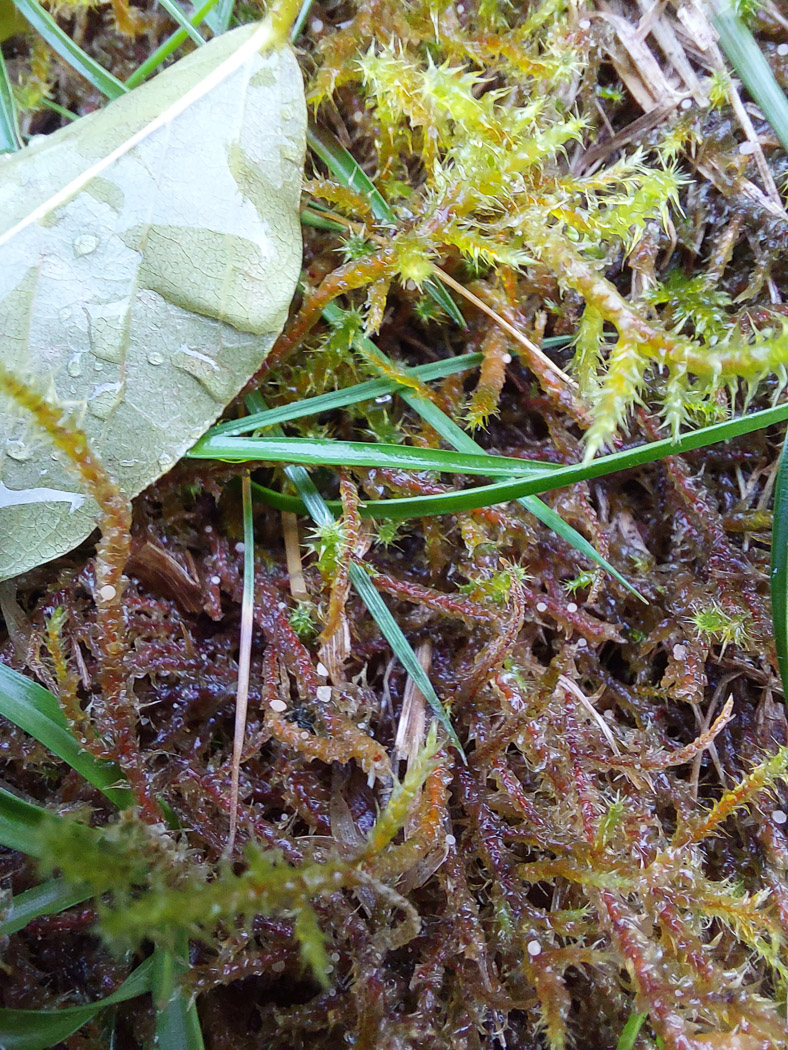
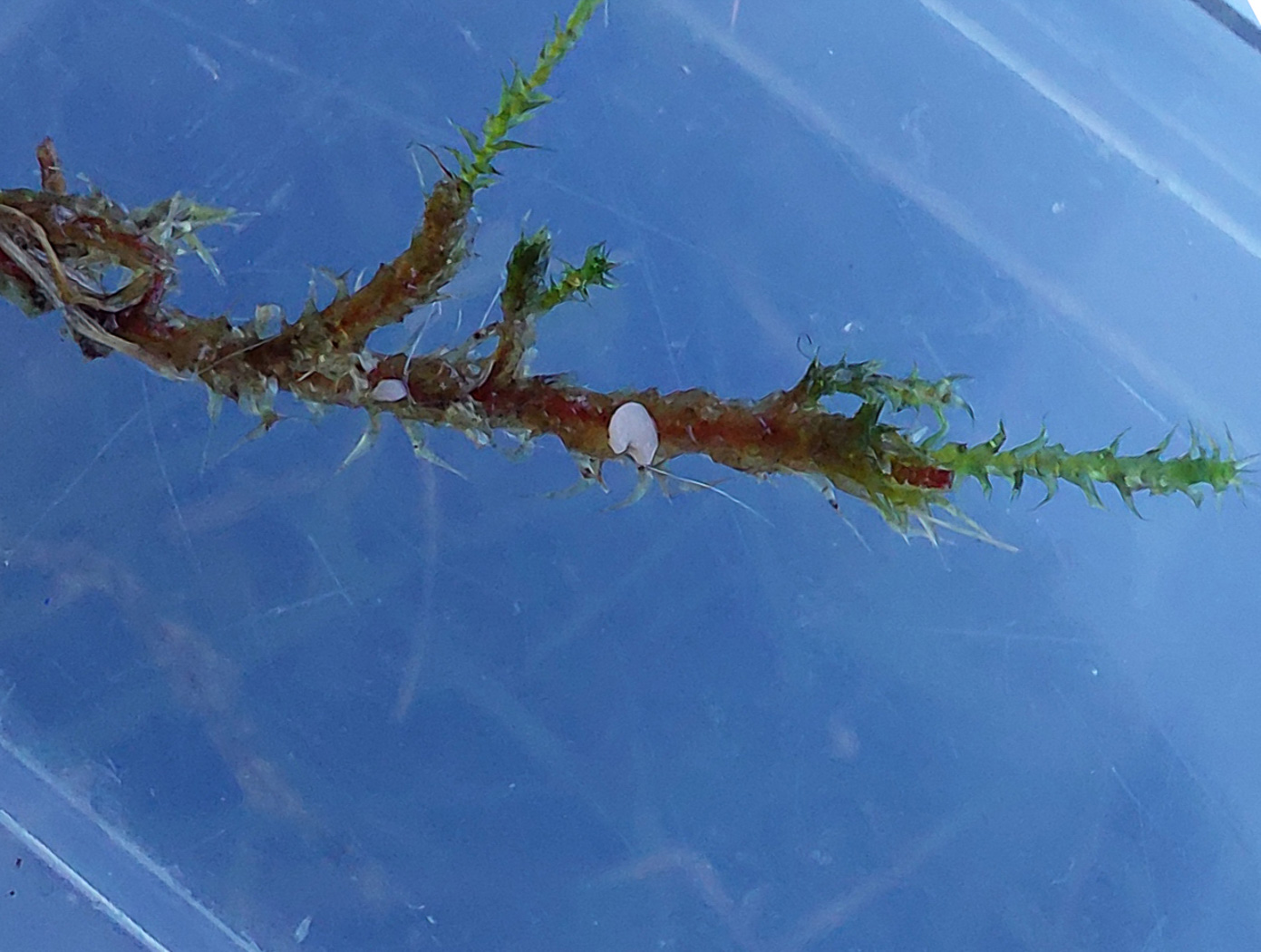
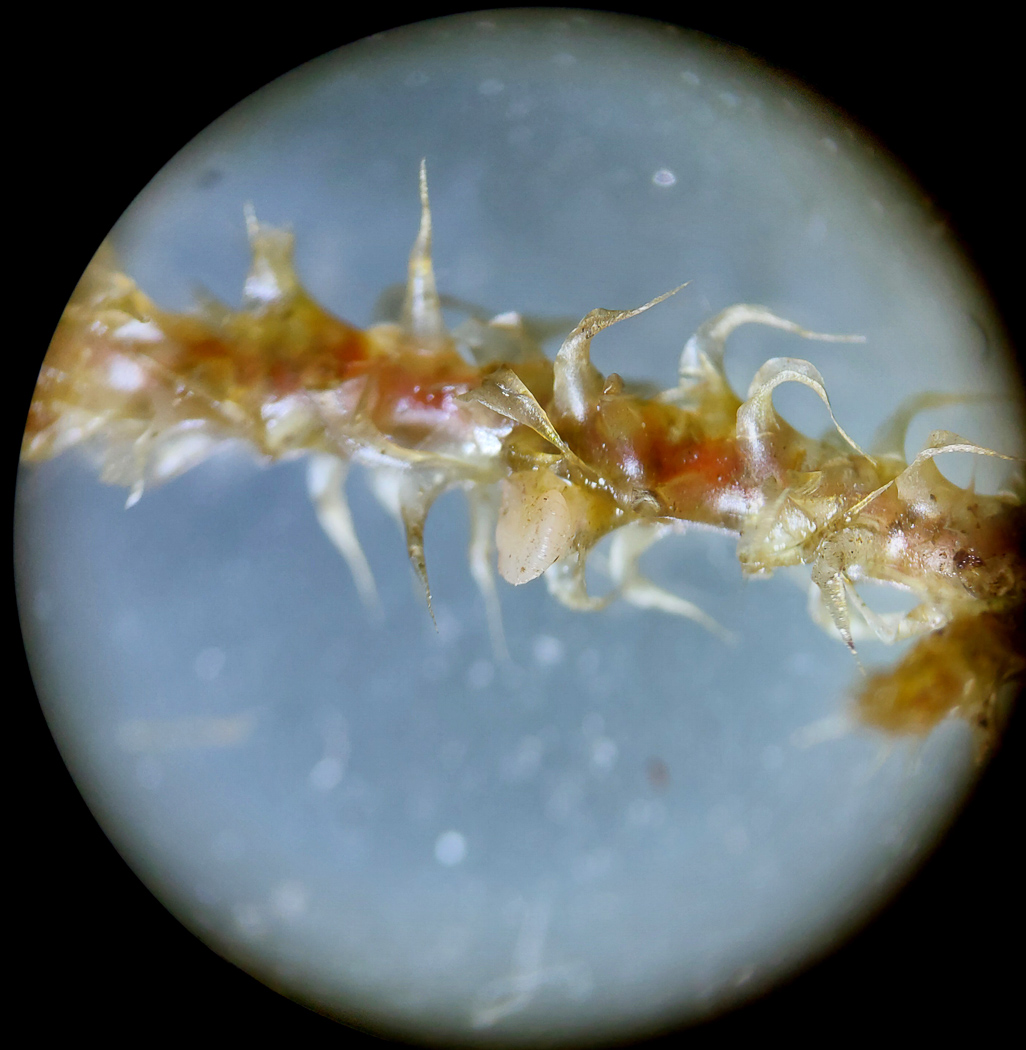
|
Dec 8, 2025.  In Stoke Poges Memorial Gardens Jesper Launder's eye was caught by some miniscule pale cream discs while closely inspecting a patch of moss which, realising it might well have some significance to a possible identification of the fungus, he was able to identify as Rhytidiadelphus squarrosus (Springy Turf Moss). At home the piece of moss he'd collected appeared to have just one fruitbody still in tact which allowed him to make microscopic assessment and led to this identification - a species apparently known to occur on this particular moss though there are only 4 previous UK records all dating from the last century. On the website AscoFrance he found information that DNA work suggests there are more species involved here hence the cf. in his identification. However, if in time it is proves to be a different species that will no doubt be new to the UK! He apologises for his photo (photo1) and only had his phone to hand which was not up to the task of coping with such tiny specimens. There are, however, a good number of these tiny discs clearly visible growing along several stems. What an exciting find! What's more, three days later he visited St. James's churchyard, Gerrards Cross, where he knew this host moss grew plentifully, and diligent searching produced 5 or 6 more tiny fruitbodies of the fungus, all under 1mm across (photos 2 and 3). So this leads him to suggest that the species is probably not that rare but just goes unnoticed for obvious reasons. In Stoke Poges Memorial Gardens Jesper Launder's eye was caught by some miniscule pale cream discs while closely inspecting a patch of moss which, realising it might well have some significance to a possible identification of the fungus, he was able to identify as Rhytidiadelphus squarrosus (Springy Turf Moss). At home the piece of moss he'd collected appeared to have just one fruitbody still in tact which allowed him to make microscopic assessment and led to this identification - a species apparently known to occur on this particular moss though there are only 4 previous UK records all dating from the last century. On the website AscoFrance he found information that DNA work suggests there are more species involved here hence the cf. in his identification. However, if in time it is proves to be a different species that will no doubt be new to the UK! He apologises for his photo (photo1) and only had his phone to hand which was not up to the task of coping with such tiny specimens. There are, however, a good number of these tiny discs clearly visible growing along several stems. What an exciting find! What's more, three days later he visited St. James's churchyard, Gerrards Cross, where he knew this host moss grew plentifully, and diligent searching produced 5 or 6 more tiny fruitbodies of the fungus, all under 1mm across (photos 2 and 3). So this leads him to suggest that the species is probably not that rare but just goes unnoticed for obvious reasons. |
| Bulbillomyces farinosus (Coucous Crust) |

 |
Aug 13, 2021.  In a stream in Rushbeds Wood Penny found this interesting and unusual fungus, one that at first glance looks like many other white corticioids but with a hand lens the tiny round white granules are quite distinctive (photo 2). Only found on soggy wood near water, this is a species which depends upon flood water to disperse the loose granules which contain the 'diaspores' - this stage of its development known as the Aegerita candida stage. This was new to the site, now one of six sites in the county where it's been found. In a stream in Rushbeds Wood Penny found this interesting and unusual fungus, one that at first glance looks like many other white corticioids but with a hand lens the tiny round white granules are quite distinctive (photo 2). Only found on soggy wood near water, this is a species which depends upon flood water to disperse the loose granules which contain the 'diaspores' - this stage of its development known as the Aegerita candida stage. This was new to the site, now one of six sites in the county where it's been found.
|
| Bulgaria inquinans (Black Bulgar / Bachelor's Buttons) |

 |
Oct 10, 2022. In Naphill Common Toni Standing found these distinctive jelly-like ascomycetes on fallen Oak. They can be mistaken for one of the black Exidia species which do not, however, stain your finger black as today's species does if you wipe your finger across the top. |

 |
Sep 15, 2022. In Downley Woods Claire Williams noticed these dark brown soft discs on fallen Oak, up to about 2 cm across. This is an ascomycete and when mature the button-like discs turn completely black - in fact if you wipe a finger across the top the black spore mass will stain your finger. This is a useful diagnostic feature, separating the species from the quite similar genus Exidia (which is a Basidiomycete). |

 |
Oct 11, 2020. This quite common Ascomycete was fruiting in good numbers on fallen Oak in Pullingshill Wood, found by Penny Cullington. Photo 1 shows young fruit bodies, not yet fully expanded, often with a reddish tinge and with the rough outer surface visible. Photo 2 shows mature black fruit bodies which are more or less flat discs with a short stem. This species is easily confused with a species of Exidea, also black and quite gelatinous (though not an Ascomycete). To check you have today's species, rub your finger over the black surface and it will be stained black by the spores. If it doesn't do so then you have something different! |
| Butyriboletus appendiculatus (Oak Bolete) |
 |
Sep 11, 2022. Under Oak in Bradenham Woods Wendy Nicholson found this unusual bolete - more familiar by its previous name when in genus Boletus.This is one of our larger boletes - very solid fleshed like B. edulis though the pores are yellow even when young, bluing slightly when pressed, and the cap is a more cinnamon brown. The stem has fine concolorous network markings, and another feature which helps to confirm identification is its overlapping cuticle at the margin - hence its species name. It occurs under Beech and Oak and, though described as common in some texts, we have only a handful of previous county records and it's new for Finds. |

 |
Sep 15, 2020. This quite rare bolete (previously in the genus Boletus) was found by Penny Cullington under Beech at Burnham Beeches where it appears to be new for the site. This is a firm fleshed bolete, as in B. edulis, with a brown cap, very small yellow pores which blue when pressed and a cylindrical yellow stem marked with a fine concolorous network and darker brownish towards the often rooting base. Though the common name might suggest otherwise, this species can apparently occur under Oak, Beech (as here), Lime and Hornbeam. |
| Byssomerulius corium (Netted Crust) |

 |
Mar 12, 2024. At Burnham Beeches our small group of forayers found a deciduous stick coated with a whitish corticioid species. Its distinctive 'merulioid' (soft, wrinkled with low ridged) surface and ease of peeling away from its substrate made it nameable in the field by several members present. This is one of our most common flat whitish fungal species on fallen wood, most of which require specialised skills plus a scope to name. The photos are Linda Seward's. |

 |
Mar 19, 2023. On fallen deciduous wood at Turville Heath Penny noticed several patches of this corticioid - one which can be recognised by its pinkish buff colour with white fringe. However, do not confuse in the field with Steccherinum ochraceum and fimbreatum which can looks quite similar at first glance but - viewed with a handlens - the Steccherinum upper surface is covered in fine 'teeth' rather than being smooth to wrinkled / rubbery as here. |


 |
Dec 30, 2022. In woodland near Chalfont St. Peter Jim Wills noticed the white edges of this common corticioid species protruding from the underside of a deciduous fallen twig (photo 1). Turning it over revealed the complete flattish fruitbody (photo 2) and nearby he found a more mature example which had developed the typical reticulated surface reflected in its common name (photo 3). Another feature to help confirm its identity in the field is that it peels off its substrate very easily. Jim also checked the spore shape and size. |
 |
Jan 6, 2021. On Joanna Dodsworth's walk around Brill she noticed this common corticioid species covering a deciduous stick. It has a somewhat leathery consistency and is quite easy to peel off the substrate - a feature which helps to separate it from the many other similar flattish white resupinate species. It can be found at any time of year but as it happens is not one we included in Finds 2020. |
| Byssonectria terrestris (Butterycups) |

 |
Mar 25, 2023.  At Stoke Common in a heathy patch of rotting mossy vegetation Penny caught her eye in this bright orange colony of tiny discs and immediately wondered if she'd found the very similar Aleuria congrex - new to the UK from here in 2010 and with several subsequent collections. However, a scope revealed this was very different but she was unable to identify it. Sending the details plus microphotos to expert Paul Cannon produced the answer, however. This is new to the county with only six previous UK records on FRDBI though there are only two species in this genus known in the UK and Paul explained that it is likely they have been confused with each other in the past. Sequencing has now confirmed this identification. At Stoke Common in a heathy patch of rotting mossy vegetation Penny caught her eye in this bright orange colony of tiny discs and immediately wondered if she'd found the very similar Aleuria congrex - new to the UK from here in 2010 and with several subsequent collections. However, a scope revealed this was very different but she was unable to identify it. Sending the details plus microphotos to expert Paul Cannon produced the answer, however. This is new to the county with only six previous UK records on FRDBI though there are only two species in this genus known in the UK and Paul explained that it is likely they have been confused with each other in the past. Sequencing has now confirmed this identification.
|

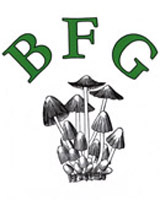































.jpg)








.jpg)
.jpg)
 Stoke Common 26.01.24 JW1.jpg)






















































_Burnham_Beeches_241204 CVS(1)m.jpg)

































